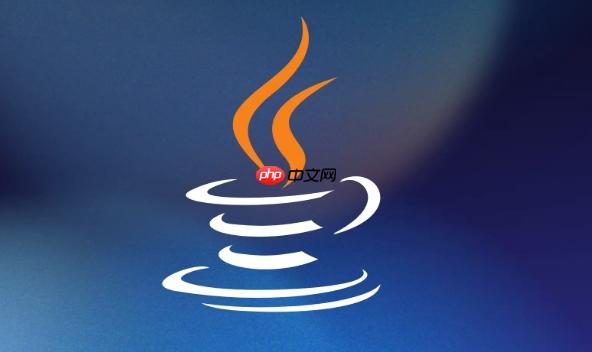用java构建restful客户端,需选择合适的http客户端库并构造请求与处理响应。1. 选择httpclient库:如java.net.http(简洁易用)、apache httpclient(功能强大)、okhttp(设计优雅,性能优秀);2. 添加依赖:如okhttp需在maven或gradle中添加对应依赖;3. 构造httprequest:设置方法、url、header、body;4. 发送请求:通过httpclient发送并获取httpresponse;5. 处理响应:解析状态码、header、body,结合gson或jackson将json转为java对象;6. 认证处理:可使用basic auth、api key、oauth 2.0、jwt,根据安全需求选择;7. 错误处理:检查状态码、解析错误信息、实现重试机制、捕获异常;8. 性能优化:使用连接池、keep-alive、gzip压缩、缓存、异步请求;9. 选择库时考虑易用性、性能、功能、社区支持、依赖与维护情况,推荐okhttp或java.net.http。

用Java构建RESTful客户端,核心在于选择合适的HTTP客户端库,并正确地构造请求、处理响应。关键步骤包括:选择HttpClient库,构造HttpRequest,发送请求,处理HttpResponse。

解决方案
选择HttpClient库:
立即学习“Java免费学习笔记(深入)”;

Java生态中有很多选择,比如:
java.net.http (Java 11+): Java标准库自带,简洁易用,性能不错。

Apache HttpClient: 老牌HTTP客户端,功能强大,社区支持广泛。
OkHttp: Square公司出品,在Android开发中很流行,也适用于Java后端,设计优雅,性能优秀。
个人偏好OkHttp,因为它API设计简洁,并且对HTTP/2和WebSocket支持良好。选择哪个库取决于你的项目需求和个人喜好。
添加依赖:
如果选择OkHttp,需要在Maven或Gradle中添加依赖。
<dependency>
<groupId>com.squareup.okhttp3</groupId>
<artifactId>okhttp</artifactId>
<version>4.11.0</version>
</dependency>implementation("com.squareup.okhttp3:okhttp:4.11.0")构造HttpRequest:
使用选定的HttpClient库,构造一个HttpRequest对象,设置请求方法(GET、POST、PUT、DELETE等)、URL、Header和Body。
import okhttp3.*;
import java.io.IOException;
public class RestClient {
private final OkHttpClient client = new OkHttpClient();
public String get(String url) throws IOException {
Request request = new Request.Builder()
.url(url)
.build();
try (Response response = client.newCall(request).execute()) {
if (!response.isSuccessful()) throw new IOException("Unexpected code " + response);
return response.body().string();
}
}
public String post(String url, String json) throws IOException {
MediaType JSON = MediaType.parse("application/json; charset=utf-8");
RequestBody body = RequestBody.create(json, JSON);
Request request = new Request.Builder()
.url(url)
.post(body)
.build();
try (Response response = client.newCall(request).execute()) {
if (!response.isSuccessful()) throw new IOException("Unexpected code " + response);
return response.body().string();
}
}
public static void main(String[] args) throws IOException {
RestClient client = new RestClient();
String response = client.get("https://www.example.com");
System.out.println(response);
String json = "{\"name\":\"John Doe\",\"age\":30}";
String postResponse = client.post("https://www.example.com/api/users", json);
System.out.println(postResponse);
}
}发送请求:
使用HttpClient发送构造好的HttpRequest,并获取HttpResponse。
在上面的例子中,client.newCall(request).execute()就是发送请求并获取响应的代码。
处理HttpResponse:
从HttpResponse中获取状态码、Header和Body。通常需要根据状态码判断请求是否成功,并根据Content-Type将Body解析成Java对象。
例如,如果Content-Type是application/json,可以使用Gson或Jackson等库将Body解析成Java对象。
import com.google.gson.Gson; // ... 在get或post方法中 String responseBody = response.body().string(); Gson gson = new Gson(); MyObject myObject = gson.fromJson(responseBody, MyObject.class);
如何处理REST API的认证和授权?
认证和授权是REST API的重要组成部分。常见的认证方式包括:
Basic Authentication: 将用户名和密码进行Base64编码,放在Authorization Header中。简单但安全性较低,不推荐在生产环境中使用。
API Key: 为每个用户分配一个唯一的API Key,放在请求的Header或Query String中。实现简单,但安全性也有限。
OAuth 2.0: 一种授权框架,允许第三方应用在用户授权的情况下访问用户的资源。安全性较高,但实现较为复杂。
JWT (JSON Web Token): 一种基于Token的认证方式,将用户信息加密成Token,放在请求的Header中。无状态,易于扩展。
选择哪种认证方式取决于你的应用场景和安全需求。如果安全性要求不高,可以使用API Key。如果需要支持第三方应用,可以使用OAuth 2.0。如果需要无状态的认证,可以使用JWT。
以下是一个使用OkHttp和JWT的例子:
import okhttp3.*;
import java.io.IOException;
public class JWTClient {
private final OkHttpClient client = new OkHttpClient();
private String jwtToken;
public JWTClient(String username, String password) throws IOException {
// 假设有一个登录接口,返回JWT Token
String loginUrl = "https://www.example.com/api/login";
MediaType JSON = MediaType.parse("application/json; charset=utf-8");
String json = String.format("{\"username\":\"%s\",\"password\":\"%s\"}", username, password);
RequestBody body = RequestBody.create(json, JSON);
Request request = new Request.Builder()
.url(loginUrl)
.post(body)
.build();
try (Response response = client.newCall(request).execute()) {
if (!response.isSuccessful()) throw new IOException("Unexpected code " + response);
// 假设登录接口返回的JSON包含token字段
String responseBody = response.body().string();
// 使用Gson或Jackson解析JSON
// 这里简化处理
this.jwtToken = "your_jwt_token"; // 替换为实际的token解析代码
}
}
public String get(String url) throws IOException {
Request request = new Request.Builder()
.url(url)
.header("Authorization", "Bearer " + jwtToken) // 添加JWT Token
.build();
try (Response response = client.newCall(request).execute()) {
if (!response.isSuccessful()) throw new IOException("Unexpected code " + response);
return response.body().string();
}
}
public static void main(String[] args) throws IOException {
JWTClient client = new JWTClient("user", "password");
String response = client.get("https://www.example.com/api/protected");
System.out.println(response);
}
}如何处理REST API的错误和异常?
处理REST API的错误和异常至关重要,可以提高应用的健壮性和用户体验。常见的错误处理方式包括:
检查HTTP状态码: REST API通常会返回HTTP状态码来表示请求的结果。例如,200表示成功,400表示客户端错误,500表示服务器错误。
解析错误信息: REST API通常会在Body中返回错误信息,可以解析这些信息来了解错误的具体原因。
重试机制: 对于一些临时性的错误,可以尝试重试请求。
异常处理: 使用try-catch块捕获异常,并进行相应的处理。
以下是一个使用OkHttp处理错误的例子:
import okhttp3.*;
import java.io.IOException;
public class ErrorHandlingClient {
private final OkHttpClient client = new OkHttpClient();
public String get(String url) throws IOException {
Request request = new Request.Builder()
.url(url)
.build();
try (Response response = client.newCall(request).execute()) {
if (!response.isSuccessful()) {
// 检查状态码
int statusCode = response.code();
String errorMessage = response.body().string(); // 获取错误信息
if (statusCode == 404) {
// 处理404错误
System.out.println("Resource not found: " + url);
} else if (statusCode >= 500) {
// 处理服务器错误,可以尝试重试
System.out.println("Server error, retrying...");
// 可以在这里添加重试逻辑
} else {
// 处理其他错误
System.out.println("Request failed with status code " + statusCode + " and message: " + errorMessage);
}
throw new IOException("Request failed with status code " + statusCode);
}
return response.body().string();
} catch (IOException e) {
// 处理IO异常
System.err.println("IO Exception: " + e.getMessage());
throw e; // 重新抛出异常,让上层处理
}
}
public static void main(String[] args) throws IOException {
ErrorHandlingClient client = new ErrorHandlingClient();
try {
String response = client.get("https://www.example.com/api/nonexistent");
System.out.println(response);
} catch (IOException e) {
// 处理异常
System.err.println("Main method caught exception: " + e.getMessage());
}
}
}如何提高RESTful客户端的性能?
RESTful客户端的性能优化是一个重要的课题,可以从以下几个方面入手:
连接池: 使用连接池可以重用HTTP连接,避免频繁创建和销毁连接的开销。OkHttp默认使用连接池。
Keep-Alive: 启用Keep-Alive可以保持HTTP连接的持久性,减少TCP连接的建立和关闭次数。OkHttp默认启用Keep-Alive。
Gzip压缩: 启用Gzip压缩可以减少传输的数据量,提高传输速度。
缓存: 使用缓存可以避免重复请求相同的数据。
异步请求: 使用异步请求可以避免阻塞主线程,提高应用的响应速度。
以下是一个使用OkHttp启用Gzip压缩和异步请求的例子:
import okhttp3.*;
import java.io.IOException;
import java.util.concurrent.CompletableFuture;
public class PerformanceClient {
private final OkHttpClient client = new OkHttpClient.Builder()
.addInterceptor(new GzipRequestInterceptor()) // 添加Gzip拦截器
.build();
public CompletableFuture<String> getAsync(String url) {
Request request = new Request.Builder()
.url(url)
.build();
CompletableFuture<String> future = new CompletableFuture<>();
client.newCall(request).enqueue(new Callback() {
@Override
public void onFailure(Call call, IOException e) {
future.completeExceptionally(e);
}
@Override
public void onResponse(Call call, Response response) throws IOException {
if (!response.isSuccessful()) {
future.completeExceptionally(new IOException("Unexpected code " + response));
return;
}
try (ResponseBody responseBody = response.body()) {
future.complete(responseBody.string());
}
}
});
return future;
}
// Gzip 拦截器
static class GzipRequestInterceptor implements Interceptor {
@Override
public Response intercept(Chain chain) throws IOException {
Request originalRequest = chain.request();
if (originalRequest.body() == null || originalRequest.header("Content-Encoding") != null) {
return chain.proceed(originalRequest);
}
Request compressedRequest = originalRequest.newBuilder()
.header("Content-Encoding", "gzip")
.method(originalRequest.method(), gzip(originalRequest.body()))
.build();
return chain.proceed(compressedRequest);
}
private RequestBody gzip(final RequestBody body) {
return new RequestBody() {
@Override
public MediaType contentType() {
return body.contentType();
}
@Override
public long contentLength() {
return -1; // 无法提前知道压缩后的长度
}
@Override
public void writeTo(BufferedSink sink) throws IOException {
BufferedSink gzipSink = Okio.buffer(new GzipSink(sink));
body.writeTo(gzipSink);
gzipSink.close();
}
};
}
}
public static void main(String[] args) throws Exception {
PerformanceClient client = new PerformanceClient();
CompletableFuture<String> future = client.getAsync("https://www.example.com");
future.thenAccept(response -> {
System.out.println("Response: " + response);
}).exceptionally(e -> {
System.err.println("Error: " + e.getMessage());
return null;
}).join(); // 等待异步请求完成
}
}注意:需要添加Okio依赖:
implementation("com.squareup.okio:okio:3.6.0")如何选择合适的Java REST客户端库?
选择合适的Java REST客户端库,需要考虑以下几个因素:
易用性: API设计是否简洁易懂,是否容易上手。
性能: 性能是否满足需求,是否支持连接池、Keep-Alive、Gzip压缩等优化手段。
功能: 功能是否满足需求,是否支持各种认证方式、异步请求、WebSocket等高级功能。
社区支持: 社区是否活跃,是否有完善的文档和示例。
依赖: 依赖是否过多,是否存在版本冲突的风险。
维护: 是否长期维护,是否有安全漏洞修复。
综合考虑以上因素,选择最适合你的项目需求的Java REST客户端库。 个人推荐OkHttp,因为它API设计简洁,性能优秀,社区活跃,并且对HTTP/2和WebSocket支持良好。 当然,java.net.http也是一个不错的选择,特别是如果你只需要简单的HTTP客户端功能,并且不想引入额外的依赖。
以上就是如何用Java构建RESTful客户端 Java调用REST接口的方法的详细内容,更多请关注php中文网其它相关文章!

每个人都需要一台速度更快、更稳定的 PC。随着时间的推移,垃圾文件、旧注册表数据和不必要的后台进程会占用资源并降低性能。幸运的是,许多工具可以让 Windows 保持平稳运行。

Copyright 2014-2025 https://www.php.cn/ All Rights Reserved | php.cn | 湘ICP备2023035733号